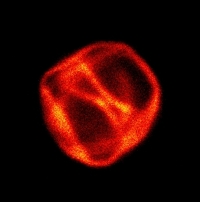
Max Planck Institute for Polymer Research, Ackermannweg 10, D-55128 Mainz, Germany
e-mail: lebedeva@mpip-mainz.mpg.de

 |
Olga V. Lebedeva, Byoung-Suhk Kim, Haofei Gong,
Krasimir Vasilev, Javier Garcia-Turiel, and Olga I. Vinogradova
Max Planck Institute for Polymer Research, Ackermannweg 10, D-55128 Mainz, Germany e-mail: lebedeva@mpip-mainz.mpg.de |
 |
We report the preparation, characterization, and mechanical properties of DNA/poly(allylamine hydrochloride) (PAH) multilayer microcapsules. The DNA/PAH multilayers were first constructed on planar support to examine their layer-by-layer build-up. Surface plasmon resonance spectroscopy (SPR) showed a nonlinear growth of the assembly upon each bilayer deposited independently on a concentration of salt. A weak increase in the film thickness with the DNA concentration was, however, detected. The optimal conditions of the planar film growth were used to deposit the same multilayers on the surface of colloidal templates and to study their roughness and morphology with the atomic force microscope (AFM) imaging. When an outer layer is formed by DNA we observe large domains of oriented parallel DNA loops, while an outer layer formed by PAH shows highly porous morphology. The dissolution of colloidal templates led to a formation of highly porous DNA/PAH microcapsules. We probe their mechanical properties by measuring force-deformation curves with the AFM-related set-up. The experiment suggests that the DNA/PAH capsules are softer than capsules made from fully flexible polyelectrolytes studied before. The softening is due to both higher permeability and smaller Young's modulus of the shell material.